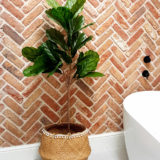Brick slips, with their versatility and aesthetic charm, have revolutionised the design world. But have you ever wondered how these thin slices of brick are made? Here, we’ll guide you through the fascinating journey of brick slip production, from start to finish.
The Journey Begins: Choosing the Right Clay
Brick slips, like their full-sized counterparts, begin life as clay. The choice of clay significantly impacts the final product’s quality, colour, and texture. Clay selection is a delicate process, with factors such as mineral content, purity, and consistency all coming into play.
Moulding: The Birth of a Brick
Once the clay has been selected, it undergoes moulding to shape it into a brick. This can be done through a variety of methods, including wire cut, press moulded, or water struck, each giving a different texture and finish to the brick.
Drying: Preparing for the Kiln
After moulding, the bricks need to dry. This stage is crucial to prevent the bricks from cracking or exploding in the kiln. Drying also makes the clay more durable, preparing it for the extreme temperatures it will face in the kiln.
Firing: The Transformation
Firing is where the real transformation occurs. The bricks are loaded into a kiln and exposed to high temperatures. This process hardens the clay and brings out the bricks’ colour. The temperature, duration of firing, and the atmosphere in the kiln can all affect the bricks’ final appearance.
Slicing: The Birth of Brick Slips
Once the bricks have been fired and cooled, they are sliced into thin slips using a diamond blade saw and high pressure water jets. This process requires precision to ensure the slips are uniform in thickness and maintain the integrity of the brick’s face.
Quality Control: Ensuring the Best Product
Finally, every brick slip goes through a strict quality control process. This involves checking the slips for consistency in size, colour, and texture. Only the slips that meet the high standards are packaged and shipped out.
Conclusion
The production of brick slips is a process that combines traditional brick-making techniques with modern precision tools. Each step, from selecting the right clay to the final quality control, is meticulously carried out to ensure the final product’s quality, durability, and aesthetic appeal. Next time you see brick slips adorning a wall, you’ll have a newfound appreciation for the art and craft that went into their creation.
Frequently Asked Questions
1. Are brick slips as durable as regular bricks?
Yes, brick slips are just as durable as regular bricks. Despite their thinner profile, they undergo the same rigorous production process and can withstand wear and tear.
2. Can brick slips be used outdoors?
Absolutely! Brick slips are suitable for both indoor and outdoor use. They are weather-resistant and can withstand the elements.
3. How are brick slips installed?
Brick slips are installed much like regular tiles. They are affixed to a substrate using adhesive, and then the gaps between the slips are filled with mortar to complete the look of a brick wall.
































